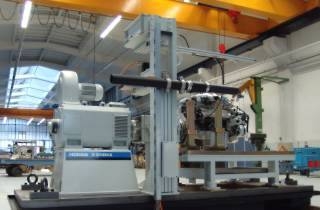
An engine test stand can be very expensive and require adjustments to different engine sizes. One can construct an engine test stand from relatively inexpensive parts that are specifically designed for the engine that is being tested. An engine test stand essentially allows a person to run an engine while not inside a vehicle in order to discover if there are any defects in its operation. This enables someone to fix problems that may arise without having to work around the rest of the car. When constructing an engine test stand, it is important to remember all of the components needed to properly operate an engine. The motor needs gauges, electricity, exhaust and a cooling device. Here are some helpful tips for tackling this project.
Lift the engine up to the desired height using an engine hoist. This should probably be around 4 feet off the ground. A metal frame will need to be constructed around the engine. Using two pieces of metal, 1 square inch thick and 4 feet tall, place them vertical near the rear of the engine. Attach the bolts on the rear mounts of the engine into the metal pieces. Ensure that the bottoms of the metal are securely positioned on the floor. Repeat for the front engine mounts. Weld four metal strips to the base of the metal rods, creating a secure base around the entire engine. Release the engine from the hoist.
Drill three holes in a small wooden block for the oil pressure gauge, water temperature gauge and tachometer. Make sure the holes correlate with the size of the gauges. Place the gauges in the holds and secure down with screws. Plug the wires into the corresponding sensors on the engine. Locations for these vary by design.
Place a muffler and its tubing into the muffler port on the engine. Fasten the muffler itself to the base of the test stand underneath the engine. This should provide adequate exhaust for the engine during testing.
Fasten the radiator to the front of the metal frame. Run hoses from the radiator to the engine. This will keep the engine from overheating. An additional sensor for the water temperature gauge is usually located on the radiator. Make sure that the gauge is also attached to this sensor for greater accuracy of engine temperature.
Place a car battery at the base of the test stand. Run the hot and ground cables to the necessary points on the engine block. By using a car battery to power the engine, an alternator is unnecessary. This will provide greater stability for the engine during periods of troubleshooting by not having to worry about proper alternator performance. Turn on the engine and perform the tests needed.